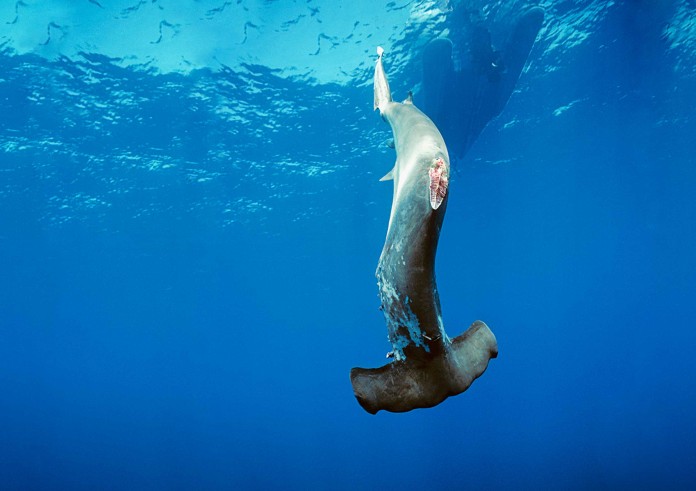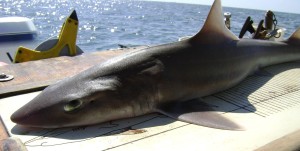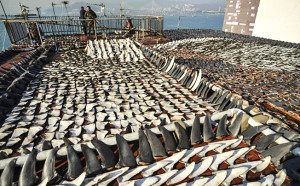
The oceans boil red with the blood of prehistoric creatures that survived tens of millions of years but now greet extinction at the hands of modern man
By Mark Cromer
It’s an extinction level event marked fittingly by the debut of Pokémon Go this summer: as more than 100 million sharks will be slaughtered in the world’s oceans by the end of this year, more than 100 million humans across the planet have now downloaded their latest dose of digital heroin and have emerged from their tech-dens to roam the streets in a distracted stupor that keeps them oblivious to reality as it unfolds on Earth.
There’s a delicious irony in it all, as shark finning fleets strip-mine the oceans of a prehistoric species to satiate Asia’s unquenchable appetite for ‘shark-fin soup’ as well as its purported medicinal powers, the continent is kind enough to produce the digital fantasy smack to feed the masses junked-up on tech and send them stumbling across cemeteries looking for non-existent creatures to capture.
It’s a goof of Satanic proportions and it indeed heralds a dramatic acceleration of humankind’s mass unraveling in what amounts to a murder-suicide plan for the planet, with humans killing the Earth in installments even as they surrender their own lives in a long retreat into someplace called ‘virtual reality.’
Among the still cognizant, efforts to stop the floating slaughterhouses, even in the United States Capitol, have proven too little, too late, and continues to face opposition even as the end of sharks draws near. New Jersey’s Sen. Corey Booker recently introduced legislation that would ban even the possession of shark fins, a tightening of the law that was supposed to end the practice of ‘finning’ sharks domestically.
Under current law, U.S. fishermen are prohibited from finning sharks per se, wink-wink, but are able to hunt sharks en mass and fin them as long as the rest of the shark is processed as well. More simply put, American fishermen are free to fin as long as they don’t throw the still writhing body of the shark back overboard as soon as its fins are sliced off—the favored practice by foreign finning outfits.
And while Taiwan, Japan and India are major shark finning countries, nations from all over the globe deploy finning-fleets, with the largest supplier being Spain, according to the conservation group Shark Angels. Other major shark fin suppliers include Norway, Britain, France, Portugal, Mexico, Yemen and the United Arab Emirates.

There are currently more than 400 commercially licensed sharking operations in the U.S. and they killed 600-metric tons of sharks along the eastern seaboard in 2014 alone. Most of the shark fins taken by U.S. fleets are sold overseas, primarily though Hong Kong, which handles upwards of 80-percent of the shark finning trade, but that doesn’t mean America doesn’t have a taste for shark fin soup. According to Connecticut Sen. Richard Blumenthal, who also supports Booker’s legislation to ban the practice almost completely, the American market for shark fins saw 36-tons of them imported to domestic locations annually between 2000 and 2011. That’s 36-tons of shark fins sold in America every single year for more than a decade.
As grim as that figure is, it is dwarfed by the markets in Asia, particularly China, Hong Kong, Malaysia, Taiwan and Thailand. According to conservation groups, in 1985 more than 3,000 metric tons of shark fins were taken, a figure that jumped to more than 7,000 metric tons of shark fins taken in 1997. Marine biologists believe that number grew exponentially and in 2006 more sharks were commercially killed than at any previous time since humans started counting.
However, the U.S. fishing fleets are opposing Booker’s legislation on a very simple basis: if they don’t do it, someone else will. Using that logic—if one can call that logic—the United States should jump back into the international ivory trade and return to the whaling game while there are still some elephants and whales to be killed.
And, of course, there’s the ‘job card’ to play.
Lawyers representing the domestic sharking industry are now working the halls of Congress making the case that if Booker’s legislation becomes law, an already limping industry would be devastated. They argue that since much if not most of the cash value in a shark’s carcass is in its fins, there’s no real point for the fleets to leave port if they can’t slice and dice their prey as they see fit, even if they are on the brink of extinction. Perhaps as an ill-advised compromise, Booker’s bill contains an exemption that will allow domestic sharkers to continue to fin Mustelus canis—the ‘Smooth Dogfish’ shark, which is found in the Western Atlantic along the coasts of the Americas.

In the fine tradition of Congress: the bill to close the loopholes contains a loophole.
But it matters not whether Booker’s belated bill passes, as the fate of the sharks—and with them the planet—has past the tipping point and humanity’s slide deeper into a self-induced semi-coma where animated creatures are fetishized and ‘collected’ while real species of magnificent creatures are dragged from the seas and butchered on deck.
At times it is hard to believe that more than forty years have passed since Peter Benchley’s novel Jaws riveted the nation’s beachgoers, stirring in them an instinctive trepidation of what shadows lurk beneath the waves, only to be gripped in popcorn-spilling fear the following summer of 1975 as Stephen Spielberg’s film adaption seared the Great White Shark forever into America’s collective consciousness.
The primal dread tapped by the classic film spawned sequels that weren’t terrifying, but rather just terrible, and originated a genre of shark movies from 1981’s Great White to 1999’s Deep Blue Sea to this year’s The Shallows. When movie studios haven’t been casting the shark as the heavy on the big screen, Hollywood has been busy portraying them as either “serial killers” as Discovery Channel has named some of its episodes in ‘Shark Week’ or as aquatic mutants, as in Syfy Channel’s bizarre programing of Sharknado and Sharktopus.
The made-intentionally-bad-for-television offerings like Malibu Shark Attack, Jersey Shore Shark Attack and Ghost Shark (which features a shark that attacks hapless humans in the ocean, in swimming pools and, yes, in bathtubs) play heavily on a ‘slasher-film’ formula of cheesecake and gore, essentially just swapping out the psychopath swinging a machete or chainsaw for a shark prowling ever more make-believe waters.
The gore sweeping across the oceans, however, is all too real.
The mass fishing and finning of sharks is an unparalleled slaughter in its scope and depth, surpassing the twin 19th Century nadirs of the annihilation of the vast buffalo herds that once filled the North American plains and driving the once thriving whale populations to the brink of extinction, which saw most whale populations eliminated by more than 90-percent. While the world ostensibly banned commercial whaling in 1986—which was like shouting ‘cease fire!’ after they ran out of ammo and already killed everything they could—Norway, Iceland and Japan continue to slaughter whales as the International Whaling Commission does what bureaucratic agencies are designed to do: nothing.
Today, the great sharks of the Atlantic, including the Hammerhead, Great White, Tiger, Bull and other sharks, are believed by many marine biologists to have already passed the point of saving, with the rates they are being killed outpacing their reproductive rates and other stresses. Many species have seen more than a 90-percent decline in population numbers.
Still in the seas but not for much longer, they are dead sharks swimming.

And yet humankind continues to portray the shark as a threat, a surreal perversion of reality that perhaps suggests as sharks are hunted to extinction what remains of thinking humanity seeks to absolve itself through depicting the shark as an eternal menace.
A documentary on Naked Science intoned sharks are “Killers of the deep. Vicious man-eaters!”
And the Discovery Channel’s Wrath of a Great White Serial Killer, which ostensibly charts a rise of Great Whites encountered along the coast of the Pacific Northwest, the shark is promoted as a Ted Bundy of the sea: “In our previous Serial Killer specials we looked at a series of attacks off California’s Surf Beach, but now the investigation has gotten personal,” says television dog-trainer Brandon McMillan. “A friend of mine was brutally bitten by a white shark off Oregon and I want to know why… Why would a massive Great White Shark travel thousands of miles from across the Pacific into the icy-cold waters off Oregon? Why would they migrate to an area where Great Whites aren’t supposed to go?”
Where Great Whites aren’t supposed to go.
In actuality, McMillan surely knows that Great Whites had been found in virtually every ocean and sea across the planet not all that long ago. The question now simply is there anywhere left for them to go besides their mass grave?
And the tragic answer is clear: no, there is nowhere they can escape the deadly clutch of humankind. It’s just a shame more Pokémon Go players don’t go swimming just past the breakers at dawn and dusk.










